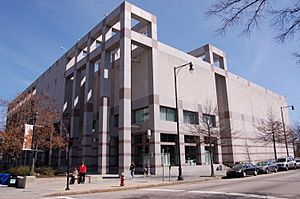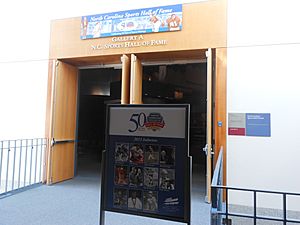North Carolina Museum of History facts for kids
 |
|
 |
|
| Lua error in Module:Location_map at line 420: attempt to index field 'wikibase' (a nil value). | |
| Established | 5 December 1902 (as "Hall of History") |
|---|---|
| Location | Raleigh, NC |
| Type | history museum |
| Visitors | 579,236 (2017) |
The North Carolina Museum of History is a cool place to learn about the past. It's a history museum located in downtown Raleigh, North Carolina. This museum is connected with the famous Smithsonian Affiliations program. It's also part of the Division of State History Museums. This division helps preserve North Carolina's rich history.
Contents
Discovering North Carolina's Past
The North Carolina Museum of History has a long and interesting story. It all started with a man named Frederick Augustus Olds. People called him the "father" of the museum. He loved collecting old items from all over North Carolina.
How the Museum Began
In the late 1800s, Frederick Olds traveled to every single county in North Carolina. He didn't just collect objects. He also gathered the stories behind them. This idea of using stories to share history is still important at the museum today.
On December 5, 1902, Olds combined his huge collection with items from the State Museum. This new collection was called the "Hall of History." It opened to the public with 37 display cases. These cases held many different things. For example, there was a shoe buckle owned by James Iredell. There was also a death mask of Confederate General Robert Hoke. To honor Olds, a metal statue of him stands outside the museum. He greets visitors along with statues of craftsman Thomas Day and a Sauratown woman.
Finding a Permanent Home
The North Carolina Historical Commission took over the Hall of History in 1914. They moved the collection to the Ruffin Building. But the hall quickly became too big for that space. In 1939, it moved again to the Education Building. This new spot was designed especially for artifacts and exhibits.
On July 1, 1965, the Hall of History got a new name. It became the North Carolina Museum of History. The collection kept growing. More exhibit space and staff were needed. So, in 1968, the museum moved into the new Archives and History/State Library Building.
Finally, on June 16, 1988, construction began on a brand-new building. This building was just for the museum. It was completed in 1994 and cost over $29 million. The museum's permanent home is at 5 East Edenton Street. It's located between the State Capitol and the Legislative Building. The new building has many features. It includes a research library and classrooms. There's also a 315-seat auditorium. It has 55,000 square feet (5,100 m2) of exhibit space on four floors.
Tar Heel Junior Historian Association
One of the museum's most popular programs is the Tar Heel Junior Historian Association (THJHA). This program helps young people learn about history.
Joining the THJHA Clubs
The North Carolina General Assembly approved THJHA in 1953. It's a network of free clubs across the state. Students in grades 4–12 can join. Each club needs at least one adult adviser. Schools, museums, historical societies, and other groups can sponsor clubs. Clubs can be any size. The museum's THJHA staff provides support and resources. They also publish a student magazine called Tar Heel Junior Historian.
North Carolina Sports Hall of Fame
The North Carolina Sports Hall of Fame is inside the North Carolina Museum of History. It's a 4,000 square feet (370 m2) exhibit gallery on the third floor.
Celebrating Sports Heroes
The Hall of Fame started in February 1963. It celebrates amazing athletes. It honors people who have achieved great things in sports. These athletes have brought recognition to themselves and to North Carolina. The Hall inducted its first five members in December 1963. By 2010, it had 274 members.
Inductees donate items from their sports careers. In 1969, these items were displayed at the Charlotte Coliseum. Later, in 1981, the objects moved to the North Carolina Museum of History. A special gallery was planned for them in the new museum building.
Famous Sports Memorabilia
The gallery displays many cool items. You can see Richard Petty's race car. There's also Dale Earnhardt's fire suit. You might spot North Carolina State University basketball coach Jim Valvano's warm-up suit. Arnold Palmer's Ryder Cup golf bag is there too. Meadowlark Lemon's Harlem Globetrotters uniform is on display. You can also see Carolina Hurricanes captain Rod Brind'Amour's jersey from the 2006 Stanley Cup Finals. And don't miss University of North Carolina at Chapel Hill football star Charlie "Choo Choo" Justice's jersey.
For many years, basketball legend Michael Jordan was not in the Hall. He had been chosen but couldn't attend the required banquet. In 2010, it was announced that Jordan would be inducted. His ceremony happened during a Charlotte Bobcats game. Jordan owned the NBA team at that time.
Supporting the Museum
The North Carolina Museum of History has groups that help it run. These groups provide important support.
Museum Associates
The North Carolina Museum of History Associates is a membership group. They help the museum with daily costs. This includes buying new items and creating publications. They also help with promotions. As government funding has decreased, their support has become very important. Membership money helps the museum keep its programs free.
The Associates also support other regional museums. These are part of the Division of State History Museums:
- Graveyard of the Atlantic Museum, Hatteras
- Museum of the Albemarle, Elizabeth City
- Museum of the Cape Fear Historical Complex, Fayetteville
- Mountain Gateway Museum and Heritage Center, Old Fort
- North Carolina Maritime Museum, in Beaufort and Southport
The Associates also host "Museum Days" events. These events happen in different places across the state. They help more people learn about the museum.
Museum Foundation
The North Carolina Museum of History Foundation raises money. This money helps the museum and other state history museums. They work to preserve and share North Carolina's history and culture.
The Foundation collects and gives out money for several things:
- Exhibitions (displays)
- Educational programs
- Buying new artifacts
- Taking care of old objects
The Foundation also helps with building improvements. They also build an endowment for the future. An endowment is money saved for long-term support. The Foundation is a charity. Donations to it can be tax deductible.
Images for kids





